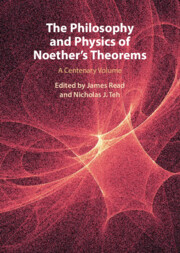Book contents
- Frontmatter
- Contents
- Contributors
- Introduction
- 1 The Noether Theorems in Context
- 2 Felix Klein and Emmy Noether on Invariant Theory and Variational Principles
- 3 Moscow, Oxford, or Princeton: Emmy Noether’s Move from Göttingen (1933)
- 4 Getting to the Bottom of Noether’s Theorem
- 5 BV Quantisation in Perturbative Algebraic QFT: Fundamental Concepts and Perspectives
- 6 Divergence Invariant Variational Problems
- 7 Do Symmetries ‘Explain’ Conservation Laws? The Modern Converse Noether Theorem vs Pragmatism
- 8 Noether’s First Theorem and the Energy-Momentum Tensor Ambiguity Problem
- 9 Noether’s Theorems and Energy in General Relativity
- 10 Geometric Objects and Perspectivalism
- 11 Substantive General Covariance and the Einstein–Klein Dispute: A Noetherian Approach
- 12 Noether Charges, Gauge-Invariance, and Non-Separability
- 13 Observability, Redundancy, and Modality for Dynamical Symmetry Transformations
- 14 The Gauge Argument: A Noether Reason
- Index
7 - Do Symmetries ‘Explain’ Conservation Laws? The Modern Converse Noether Theorem vs Pragmatism
Published online by Cambridge University Press: 22 September 2022
- Frontmatter
- Contents
- Contributors
- Introduction
- 1 The Noether Theorems in Context
- 2 Felix Klein and Emmy Noether on Invariant Theory and Variational Principles
- 3 Moscow, Oxford, or Princeton: Emmy Noether’s Move from Göttingen (1933)
- 4 Getting to the Bottom of Noether’s Theorem
- 5 BV Quantisation in Perturbative Algebraic QFT: Fundamental Concepts and Perspectives
- 6 Divergence Invariant Variational Problems
- 7 Do Symmetries ‘Explain’ Conservation Laws? The Modern Converse Noether Theorem vs Pragmatism
- 8 Noether’s First Theorem and the Energy-Momentum Tensor Ambiguity Problem
- 9 Noether’s Theorems and Energy in General Relativity
- 10 Geometric Objects and Perspectivalism
- 11 Substantive General Covariance and the Einstein–Klein Dispute: A Noetherian Approach
- 12 Noether Charges, Gauge-Invariance, and Non-Separability
- 13 Observability, Redundancy, and Modality for Dynamical Symmetry Transformations
- 14 The Gauge Argument: A Noether Reason
- Index
Summary
Noether’s first theorem, in its modern form, does not establish a one-way explanatory arrow from symmetries to conservation laws, but such an arrow is widely assumed in discussions of the theorem in the physics and philosophy literature. It is argued here that there are pragmatic reasons for privileging symmetries, even if they do not strictly justify explanatory priority. To this end, some practical factors are adduced as to why Noether’s direct theorem seems to be more well-known and exploited than its converse, with special attention being given to the sometimes overlooked nature of Noether’s converse result and to its strengthened version due to Luis Martínez Alonso in 1979 and independently Peter Olver in 1986.
- Type
- Chapter
- Information
- The Philosophy and Physics of Noether's TheoremsA Centenary Volume, pp. 144 - 168Publisher: Cambridge University PressPrint publication year: 2022
- 5
- Cited by

